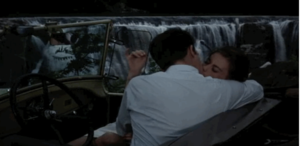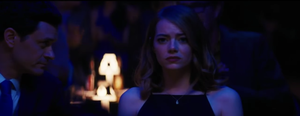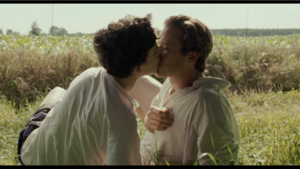Roused by truthfulness to depict reality as it prevails offscreen, directors, although very few, affiliate their films with romantic realism as a way to unveil the gentility of love to their viewers. As a young girl who was nurtured by the idyllic fantasy of Disney princess films, I was brought up into adulthood with the preconceived notion that all loves have the same head-in-the-clouds, happy endings that typically unfold with two characters who meet in a chance encounter, fall in love, overcome external forces driving them apart, kiss, and, before a roll of the credits, stating, “The End.” Unlike these conventional Hollywood romance films, Splendor in the Grass (1961), La La Land (2016), and Call Me by Your Name (2017), interpreted by means of romantic realism, unfold with two characters who meet in a chance encounter, fall in love, but don’t overcome the external forces driving them apart; thus the viewer is introduced to an authentic resolution that brings to light, transparently, the particular truths of finding and losing love. The directors for these three films are responsible for not only entertaining their viewers, but also for exposing the painful reality off the reel and deciphering it through empathy and truth.
Splendor in the Grass, directed by Elia Kazan, occurs in 1928 with two high school sweethearts taking center stage: a dewy-eyed Kansas teenager, Deanie Lewis (Natalie Wood), and a handsome football player, Bud Stamper (Warren Beatty). Although Deanie is head over heels for Bud, she follows her mother’s advice and resists sexual intercourse with him; thus Bud, sexually frustrated, turns to his father for advice, who suggests that Bud find another girl to fulfill his sexual needs. Bud’s sexual frustration drives Deanie mad, which results in a traumatic breakup after which she is sent to a mental institution in Virginia, while Bud leaves to attend college at Yale. Meeting two years and six months after they break up, and after Deanie has been sent away for emotional therapy, she seeks closure from Bud. When she arrives at his home, she is an engaged woman, while he is married with a child. While departing, Deanie asks Bud if he is happy, and he responds to her with, “I guess so, I don’t ask myself that question much… What’s the point? Ya gotta take what comes.” Although Deanie and Bud do not end up reunited, it is clear they have both found “strength in what remains behind,” driving them to maturely move on from a love that (unfairly) could not be. Kazan’s adoption of romantic realism is evident through the lack of closure Deanie from Bud after years of dealing with the repercussions of their breakup. Romantic realism is present throughout Splendor in the Grass but, to be specific, among the moments of quiet resilience, not for Deanie or Bud, but for the ideals of our youth and unfulfilled desires of what could have been. It is here where we must find strength amongst the pain and regret.
La La Land, directed by Damion Chazelle, occurs in modern-day Los Angeles, and depicts the romance of an aspiring actress, Mia (Emma Stone), and a jazz musician who dreams of opening his own jazz bar, Sebastian (Ryan Gosling). As they both gain notoriety and success from pursuing their dreams, they find themselves distanced from one another and it is up to them to decide whether their dreams will bring them closer together or tear them apart. After Mia auditions for a role in a movie that she is inclined to take, she learns that many of her months will be spent filming abroad in Paris. As she is sitting outside the Griffith Observatory, speaking with Sebastian about the filming schedule and her absence, they decide it is best if they break up, but conclude by stating, “I’m always gonna love you.” Two years later, after going their different ways, Mia, a famous actress, now married with a child, walks into a jazz bar named “Seb’s.” It is not until she walks in that she realizes she has entered Sebastian’s dream jazz bar. The film ends as they acknowledge each other, both now successful with dreams that have been fulfilled, through an exchange of eye contact, staring from afar, nostalgically longing for each other. La La Land’s romantic realism lies within the fact that their dreams come true, but another dream was right before their eyes: love. Chazelle’s film showcases dreamers who sacrificed their love in the hopes of fulfilling their dreams. Romantic realism is depicted in La La Land, specifically through their journey toward achieving their dreams, and the significance that love has altered them indefinitely, even if they did not end up together.
Call Me by Your Name, directed by Luca Guadagnino, set “somewhere in northern Italy” during 1983, is about a seventeen-year-old boy named Elio Perlman (Timothée Chalamet), who is spending his summer alongside his family at their vacation home. Elio’s father, Mr. Perlman (Michael Stuhlbarg), annually hires a doctoral student for six weeks to stay in their summer home and work under his tutelage; and this particular summer, it happens to be a handsome American named Oliver (Armie Hammer). Over the period of six weeks, Oliver and Elio grow close to one another. Curious about their sexual preferences, they begin developing emotionally and physically toward each other, and eventually end up falling in love. After spending an initially rough, but growingly beautiful six weeks together, Oliver departs to America and Elio sees him off. Six months later, Hanukkah has arrived and Elio receives a call from Oliver with the heart-wrenching news that he is engaged and soon to be married. Oliver says he will remember everything from the past summer for the rest of his existence and sends his farewell to Elio by reaffirming his love for him. Elio, who confides in his father, is advised, “To feel nothing so as not to feel anything—what a waste.” Call Me by Your Name is a romantic realist film because Mr. Perlman urges Elio to find pleasure amongst the grief of a heartbreak. Guadagnino is exposing the nature of reality that it is better to feel something than to feel nothing. Although Elio and Oliver do not end up together, it remains a romantic realist film because their love was life-changing and it was hardly as they expected it to be.
Romantic realism, unlike Hollywood cinema, depicts the complexity of finding and losing love within the universal sphere. Splendor in the Grass, La La Land, and Call Me by Your Name are examples of films that intertwine like vines to represent the universal totality of romantic realism in cinema in diverse settings and cultures (Kansas, Los Angeles, and Italy), assorted time periods (1928, 1983, and modern day), varied sexual activity (Splendor in the Grass) and orientations (heterosexuality and homosexuality), contrasting dreams as well as occupations (La La Land), and variance in ages (Call Me by Your Name). The love we experience in the world around us is not as easy and straightforward as the romantic fabrication exploited in Hollywood cinema that overcomes adversity and finds closure in unfavorable circumstances; but romantic realism explores the true nature of love through diverse and varied means. These films and their directors depict romantic realism in cinema by grounding love as the excitement that flourishes when two people meet and become attracted; but it is up to the two romantic partners to make the most of loving someone for their imperfections through a journey — long or short, pleasing or painful, metamorphic or ordinary — to capture a love that is hardly as we expect to experience it.
Author Biography
Lily C. Frame is a student at the University of North Carolina Wilmington. She adores experimental cinema, but aspires to teach the critical studies side of film. Frame’s goal is to share the same ravenous passion toward film with her students, just as her professors continue to instill within her.













































